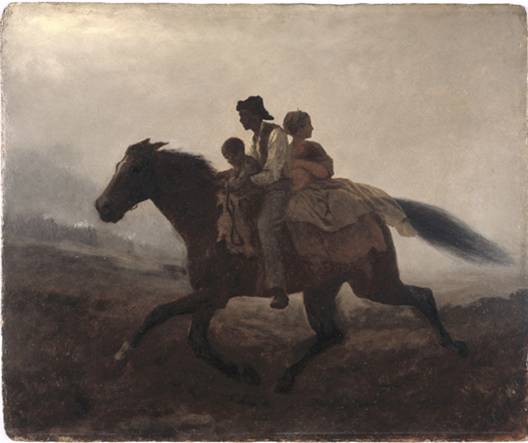
19TH CENTURY ART
|
|

-
SCRIPT – A RIDE FOR LIBERTY
SFX: NIGHT AMBIENCE...CRICKETS...LOW WIND...
March 2, 1862...Confederate and Union soldiers near Manassas, Virginia are dug in on opposite sides of a wide dirt field. Both sides know a great battle is near. So does Eastman Johnson, an artist from Maine. He can’t sleep. He’s up walking, even before the first glimmer of sunrise. In the pre dawn light he looks across the open field...and can’t believe his eyes.
SFX: HORSE RUNNING ON DIRT....GETS CLOSER
A lone horse is galloping, full out, away from the Confederate lines and across the field toward the Union fortifications. But there’s more than one rider. In fact it’s a family...father, mother, and two young children, all on one horse. They’re only silhouettes against the sky in the dim light. Why would they risk such a dangerous ride, straight into the Union muskets? And then they are closer and he can make them out...and the answer is clear. They are black, slaves attempting an escape.
It’s an incredibly dramatic moment. Is anyone chasing them? Will they make it to freedom? The moment touches Eastman Johnson deeply and stays etched in his mind. Later he will paint the scene...and title it A Ride for Liberty – The Fugitive Slaves. But he never shows the painting in public. In 1862 the outcome of the Civil War was still in doubt, and sympathetically showing slaves in flight was a daring subject for any artist, northern or southern.
SFX: LIGHT BIRDS HAVE FADED OUT... HORSE FADES AWAY
And now here’s a verbal description of Johnson’s painting.
A Ride for Liberty – The Fugitive Slaves is a small oil painting on a board.
It’s about two feet wide and one and a half feet high.
It’s a simple composition, dominated in the center by a horse galloping across an open countryside carrying a man, a woman, and two children. Since it’s just before dawn, the light is dim and all the colors in the painting are muted.
The ground is brown and dark. The horse is brown and is galloping with a long tail flying straight out behind it. The horse is facing left as it runs so we see it in profile passing before us from right to left. The man holds the reins of the horse. He wears gray pants and a white shirt with a dark vest over it. He also wears a black hat, and he’s staring intently in the direction they are riding. A small boy rides in front of the man, holding on to the horse’s mane.
Behind the man a woman rides sidesaddle on the horse’s back, so her body is facing us. She wears a full-length dress and a kerchief on her head, but in the dim light it’s hard to say what color her clothes are. In her arms she clutches a baby to her chest. The striking thing about her is that her face is in profile to the right, the direction from which the family is fleeing, as if to see if anyone is chasing them.
On the left in the background you can dimly see the walls that are fortifications of the Union troops that the family is trying to reach. Above the walls are tiny white lines, reflections of the dawning sun on the gun barrels and bayonets of the soldiers' rifles.
This painting is virtually unique in American art of the period for a few reasons. First, because there are no white people in the painting. At that time American paintings rarely showed African Americans, and then almost always with white people. Second, we see the family independently making their way to freedom without the help of white people. It was very radical for an artist to empower black people in an image of that time. Also, many people think the woman’s face has very non-typical black features. She reflects Johnson’s desire to portray African Americans as individuals, not stereotypes.
Johnson had started painting scenes from the lives of African American slaves even before the Civil War. In fact he did his most famous painting in 1859, titled Negro Life in the South.
During the Civil War, and even immediately after, very few American artists painted scenes of the war or the lives of African American slaves.



